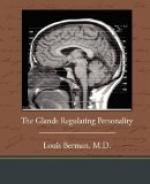To Paris then the rolling stone meandered again. So that soon after he was offered and accepted the charge of a great newly opened hospital for epileptics in London. That proved merely an interlude and in 1863 we find him back in his fatherland (if we may hold France his motherland) as Professor of Neuropathology at Harvard. In New York fame preceded him now with a thousand trumpets, so that on the day of his arrival, he was kept busy seeing patients until night, when he had to desist because of exhaustion. But still he did not prosper. An unfortunate second marriage almost broke his heart, and an attempt to found in New York a new medical periodical, the Archives of Scientific and Practical Medicine and Surgery, got him into hot water. Not until the death of Claude Bernard in 1878 left vacant the chair of physiology in the College of France, did he find peace and rest. He hastened to Paris, was appointed, and lived, in spite of the most erratic of existences, to the ripe old age of 78, working up to the last minute.
Addison’s monograph stimulated Brown-Sequard, in the year after its printing, to reproduce the fatal disease experimentally by excising the suprarenal capsules in animals. Addison was very modest in his monograph. He stated that the first case of the malady had been reported by his great predecessor at Guy’s Hospital, London, Richard Bright, the describer of Bright’s Disease. Then he talks about the “curious facts” he had “stumbled upon” and refers to an “ill-defined impression” that these suprarenal bodies, in common with the spleen and other organs, “in some way or other minister to the elaboration of the blood.” In the preface to his work he had spoken more confidently of the fact that Nature, as an experimenter and a vivisector, can beat the physiologist to a frazzle. Indeed, he begins like this: “If Pathology be to disease what Physiology is to health, it appears reasonable to conclude that, in any given structure or organ, the laws of the former will be as fixed and significant as those of the latter: and that the peculiar characters of any structure or organ may be as certainly recognized in the phenomena of disease as in the phenomena of health. Although pathology, therefore, as a branch of medical science, is necessarily founded on physiology, questions may nevertheless arise regarding the true character of a structure or organ, to which occasionally the pathologist may be able to return a more satisfactory and decisive reply than the physiologist—these two branches of medical knowledge being thus found mutually to advance and illustrate each other. Indeed, as regards the functions of individual organs, the mutual aids of these two branches of knowledge are probably much more nearly balanced than many may be disposed to admit: for in estimating them we are very apt to forget how large an amount of our present physiological knowledge respecting the functions of these organs has been the immediate result of casual observations made on the effects of disease.” William James expressed the same thought some decades later, when he emphasized that the abnormal was but the normal exaggerated and magnified, played upon by the limelight, and therefore the best teacher and indicator of the exact definition and limitations of the normal.




